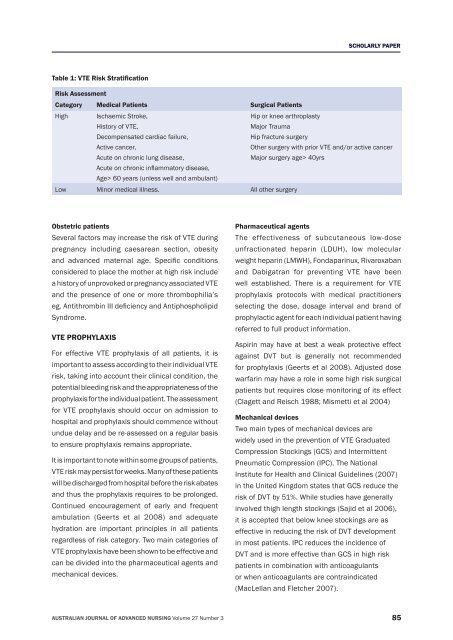March-May, 2010 - Australian Journal of Advanced Nursing
March-May, 2010 - Australian Journal of Advanced Nursing
March-May, 2010 - Australian Journal of Advanced Nursing
You also want an ePaper? Increase the reach of your titles
YUMPU automatically turns print PDFs into web optimized ePapers that Google loves.
Scholarly PAPER<br />
Table 1: VTE Risk Stratification<br />
Risk Assessment<br />
Category Medical Patients Surgical Patients<br />
High Ischaemic Stroke,<br />
History <strong>of</strong> VTE,<br />
Decompensated cardiac failure,<br />
Active cancer,<br />
Acute on chronic lung disease,<br />
Hip or knee arthroplasty<br />
Major Trauma<br />
Hip fracture surgery<br />
Other surgery with prior VTE and/or active cancer<br />
Major surgery age> 40yrs<br />
Acute on chronic inflammatory disease,<br />
Age> 60 years (unless well and ambulant)<br />
Low Minor medical illness. All other surgery<br />
Obstetric patients<br />
Several factors may increase the risk <strong>of</strong> VTE during<br />
pregnancy including caesarean section, obesity<br />
and advanced maternal age. Specific conditions<br />
considered to place the mother at high risk include<br />
a history <strong>of</strong> unprovoked or pregnancy associated VTE<br />
and the presence <strong>of</strong> one or more thrombophilia’s<br />
eg. Antithrombin III deficiency and Antiphospholipid<br />
Syndrome.<br />
VTE PROPHYLAXIS<br />
For effective VTE prophylaxis <strong>of</strong> all patients, it is<br />
important to assess according to their individual VTE<br />
risk, taking into account their clinical condition, the<br />
potential bleeding risk and the appropriateness <strong>of</strong> the<br />
prophylaxis for the individual patient. The assessment<br />
for VTE prophylaxis should occur on admission to<br />
hospital and prophylaxis should commence without<br />
undue delay and be re‐assessed on a regular basis<br />
to ensure prophylaxis remains appropriate.<br />
It is important to note within some groups <strong>of</strong> patients,<br />
VTE risk may persist for weeks. Many <strong>of</strong> these patients<br />
will be discharged from hospital before the risk abates<br />
and thus the prophylaxis requires to be prolonged.<br />
Continued encouragement <strong>of</strong> early and frequent<br />
ambulation (Geerts et al 2008) and adequate<br />
hydration are important principles in all patients<br />
regardless <strong>of</strong> risk category. Two main categories <strong>of</strong><br />
VTE prophylaxis have been shown to be effective and<br />
can be divided into the pharmaceutical agents and<br />
mechanical devices.<br />
Pharmaceutical agents<br />
The effectiveness <strong>of</strong> subcutaneous low‐dose<br />
unfractionated heparin (LDUH), low molecular<br />
weight heparin (LMWH), Fondaparinux, Rivaroxaban<br />
and Dabigatran for preventing VTE have been<br />
well established. There is a requirement for VTE<br />
prophylaxis protocols with medical practitioners<br />
selecting the dose, dosage interval and brand <strong>of</strong><br />
prophylactic agent for each individual patient having<br />
referred to full product information.<br />
Aspirin may have at best a weak protective effect<br />
against DVT but is generally not recommended<br />
for prophylaxis (Geerts et al 2008). Adjusted dose<br />
warfarin may have a role in some high risk surgical<br />
patients but requires close monitoring <strong>of</strong> its effect<br />
(Clagett and Reisch 1988; Mismetti et al 2004)<br />
Mechanical devices<br />
Two main types <strong>of</strong> mechanical devices are<br />
widely used in the prevention <strong>of</strong> VTE Graduated<br />
Compression Stockings (GCS) and Intermittent<br />
Pneumatic Compression (IPC). The National<br />
Institute for Health and Clinical Guidelines (2007)<br />
in the United Kingdom states that GCS reduce the<br />
risk <strong>of</strong> DVT by 51%. While studies have generally<br />
involved thigh length stockings (Sajid et al 2006),<br />
it is accepted that below knee stockings are as<br />
effective in reducing the risk <strong>of</strong> DVT development<br />
in most patients. IPC reduces the incidence <strong>of</strong><br />
DVT and is more effective than GCS in high risk<br />
patients in combination with anticoagulants<br />
or when anticoagulants are contraindicated<br />
(MacLellan and Fletcher 2007).<br />
AUSTRALIAN JOURNAL OF ADVANCED NURSING Volume 27 Number 3 85

















